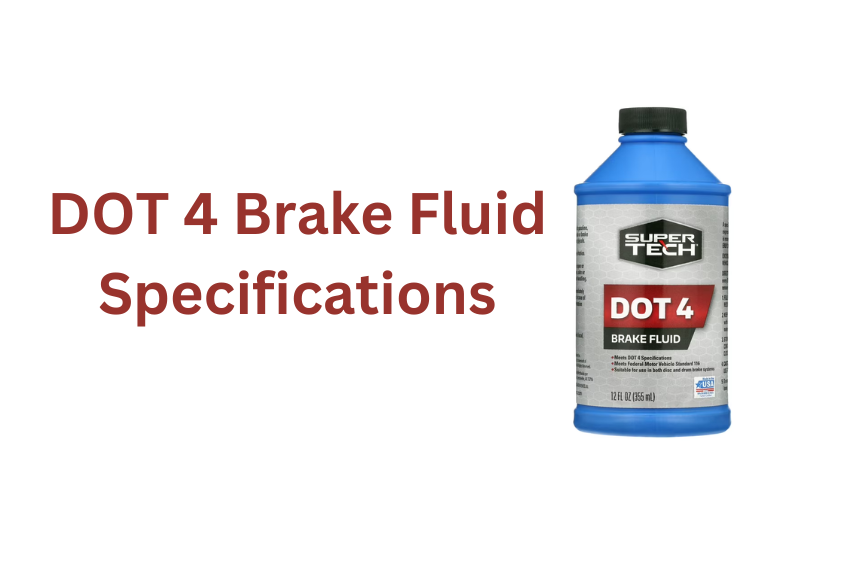This guide provides a comprehensive overview of DOT 4 brake fluid specifications, compatibility, and maintenance
What Are The DOT 4 Brake Fluid Specifications?
| Property | DOT 4 Specification |
| Boiling Point | 230°C (446°F) or higher |
| Viscosity | 3.5 centistoke (cSt) at 100°C |
| Moisture Absorption | Less than 3% |
| Dry Boiling Point | 250°C (482°F) or higher |
| Wet Boiling Point | 200°C (392°F) or higher |
| Compatibility | Compatible with most brake systems |
| Color | Typically amber or yellow |
Boiling Point:
DOT 4 brake fluid has a high boiling point, typically 230°C (446°F) or higher.
It can withstand high temperatures without vaporizing.
When brake fluid vaporizes, it can cause the brakes to feel spongy or ineffective, a condition known as “brake fade.”
A high boiling point helps prevent brake fade, especially in demanding driving conditions like racing or heavy towing.
Viscosity:
The viscosity of DOT 4 brake fluid is low, typically 3.5 centistokes (cSt) at 100°C.
This means it flows easily, ensuring quick and efficient transmission of hydraulic pressure throughout the braking system.
A low viscosity also helps prevent air bubbles from forming, which can interfere with braking performance.
Moisture Absorption:
DOT 4 brake fluid is designed to absorb minimal moisture from the atmosphere.
Moisture can reduce the boiling point of brake fluid, making it more susceptible to vaporization. A low moisture absorption rate helps maintain the fluid’s high boiling point and ensures reliable braking performance.
Dry And Wet Boiling Points:
The dry boiling point is the temperature at which the brake fluid will boil when it is completely dry.
The wet boiling point is the temperature at which the brake fluid will boil when it contains a certain amount of moisture.
Both the dry and wet boiling points of DOT 4 brake fluid are typically higher than those of DOT 3 brake fluid, providing superior performance in extreme conditions.
Compatibility:
DOT 4 brake fluid is compatible with most modern brake systems, including those with anti-lock brakes (ABS).
It can be used in a variety of vehicles, from passenger cars to trucks and SUVs.
Color:
DOT 4 brake fluid is usually amber or yellow.
This color can help in visually inspecting the fluid for signs of contamination or degradation.
Is DOT 4 Brake Fluid Compatible With ABS Systems?
Yes, DOT 4 brake fluid is compatible with ABS (Anti-lock Brake System) systems.
ABS is a safety feature that helps prevent wheel lockup during braking, especially on slippery surfaces.
It uses sensors and actuators to control the braking force of each wheel, which allows the driver to maintain steering control.
However, DOT 4 brake fluid is compatible with ABS for some good reasons:
High Boiling Point:
DOT 4 brake fluid has a higher boiling point than DOT 3, which is essential for ABS systems.
ABS systems often generate more heat during braking, and a high boiling point helps prevent the brake fluid from vaporizing.
Vaporization can reduce the fluid’s ability to transmit pressure, leading to reduced braking efficiency and potentially causing the ABS to malfunction.
Low Viscosity:
DOT 4 brake fluid has a lower viscosity than DOT 3, which is important for ABS systems.
The rapid modulation of braking force required by ABS can be more demanding on the brake fluid, and a low viscosity helps ensure that the fluid can be quickly and efficiently delivered to the calipers.
Moisture Resistance:
DOT 4 brake fluid is generally more resistant to moisture absorption than DOT 3.
Moisture can reduce the boiling point of brake fluid, making it more susceptible to vaporization.
ABS systems often operate in demanding conditions, and moisture-resistant brake fluid can help maintain optimal performance.
Can I Mix DOT 3 And DOT 4 Brake Fluid?
Yes, you can mix DOT 3 and DOT 4 brake fluid.
Both are glycol-based fluids, meaning they are chemically compatible with each other.
However, while mixing DOT 3 and DOT 4 is technically possible, it’s generally not recommended for several reasons.
Mixing DOT 3 and DOT 4 can slightly reduce the overall performance of the brake fluid.
DOT 4 has a higher boiling point than DOT 3, it can withstand higher temperatures without vaporizing.
When you mix the two, the resulting mixture may have a boiling point that is lower than that of pure DOT 4, potentially compromising braking performance in extreme conditions.
More so, the exact properties of the resulting mixture can vary depending on the proportions of DOT 3 and DOT 4.
This can make it difficult to predict the performance of the brakes, especially if the mixture is not consistent throughout the braking system.
It’s always best to follow the manufacturer’s recommendations for your specific vehicle.
